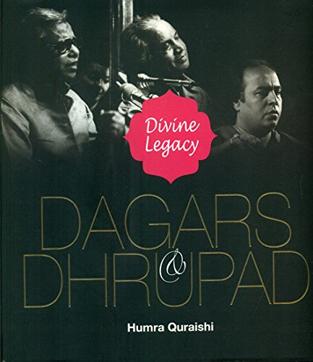Dagars & Drupad: Book pays tribute to the masters of Dagarvani
The Dagar family has produced some of the greatest practitioners of the Hindustani classical form of dhrupad. A well-researched new book pays them tribute.
Dagars & Dhrupad: Divine Legacy

Author: Humra Quraishi
Niyogi Books
Rs 1500: pp 156
Mention the Hindustani classical form of dhrupad, and music lovers would instantly talk of the Dagar family. For generations, they have been the master practitioners of the art, creating a rich and eloquent style called Dagarvani.
The story of the family’s contribution is captured in detail by Humra Quraishi in ‘Dagars & Dhrupad: Divine Legacy’. Beginning with an explanation of what dhrupad means and descriptions of the various generations of the family to the future of Dagarvani, the author impresses with her thorough research and easy narrative style.
Interestingly, Quraishi’s earlier publications include ‘Kashmir: The Untold Story’ and two books co-authored with Khushwant Singh. However, being a fan of dhrupad after attending a concert by Ustad Nasir Zahiruddin Dagar and Ustad Nasir Faiyazuddin Dagar in the mid-1980s, she developed a passion for this genre, and eventually decided to explore their magic in print. Much of the details have been provided by Faiyazuddin’s son Wasifuddin Dagar, the current torchbearer of the legacy.
Though current audiences are more exposed to and in favour of the khayal style, dhrupad has had its own following. The word has been derived from ‘dhruva’, constant or immoveable, and ‘pada’, the poetic text. Legendary musicians like Miyan Tansen, Swami Haridas, Baiju Bawra, Gopal Nayak and Nayak Bakshu have been associated with this form.

As the late Faiyazuddin Dagar has been quoted, in the two parts of the dhrupad, the ‘alap’ or prologue is sung in free rhythm over drone, whereas the ‘pada’ or words comprise a rhythmic poem accompanied by drumming over the two-headed pakhawaj. It is a devotional and spiritual type of music, whose origins trace back 15 centuries.
Though there are many schools of dhrupad singing, Dagarvani is recognised as the most representative. Performers are first made aware that this style is comparable to the Dhruv Star or Pole Star. According to Faiyazuddin, 12 or 16 hours of practice are required daily. “But then, it is such a ‘nasha’ (addiction/ passion), it carries you through all those pains and sorrows,” he says.
Besides the vocalists, the Dagar clan is also known for the contribution of veena player Ustad Zia Moiuddin Dagar, who made waves with his experiments to improve the instrument’s sound quality. The other great dhrupad veena player Ustad Asad Ali Khan, who hails from the Dhandar gharana, is quoted as saying both families had been close for four generations. “The Dagar brothers are unassuming, refined, soft-spoken and humble,” he adds.
Read: The Turn of Tortoise review
Quraishi has dedicated the book to Faiyazuddin’s wife Mehmooda Begum, mother of Wasifuddin. One of the interesting aspects is the quality of interviews with Zahiruddin, Faiyazuddin and Fahimuddin, and an insight into their lifestyle. Wasifuddin gets ample space with an interview and also some excerpts of what he has written in the book. His views on improvisation and rhythm in dhrupad would be valuable for music students. However, the lengthy part about the positives and negatives of Indian film music are out of place.
An interesting chapter revolves around the Dagar disciples, including the late journalist Sabina Sehgal Saikia and French translator Laurence Bastit. The documentary film ‘Dagarvani’ by Renuka George finds special mention. Made for French television, it describes an entire day in the house of the Dagars, with an intent of capturing the daily routine of Zahiruddin and his nephew Wasifuddin.
Read: For Love and Honour review
Besides the text, what really impresses is the quality of pictures, culled from both past and present generations. However, a few things have been overlooked. A select discography of Dagar titles could have been included. Also, since the focus is entirely on this family, the book avoids mention of other dhrupad artistes like the Gundecha brothers and Uday Bhawalkar who are currently popular in the genre.
There is one terrible error too, as legendary Hindi film lyricist Gopaldas Neeraj has been confused with comtemporary pop singer Neeraj Shridhar. While the foreword by Jawhar Sircar of Prasar Bharti is extremely articulate, he doesn’t get a proper introduction.
Those, of course, are minor flaws in a book which really brings out the true contribution of one of India’s most respected families and talks of the sheer role dhrupad has played in Indian cultural history. As ace historian Dr Romila Thapar has been quoted: “The tradition is a major heritage of Indian culture since it has a continuity which parallels that of Sanskrit literature or of classical sculpture.” The Dagar family, she adds, symbolises “an even greater strength of the Indian past, the abilities of the gurus to break the petty barriers of religion and caste, and to create a form of music which has universal appeal.”
That, surely, is a perfect summation to why readers should check out this book.
(Narendra Kusnur is a music critic who lives in Mumbai)





